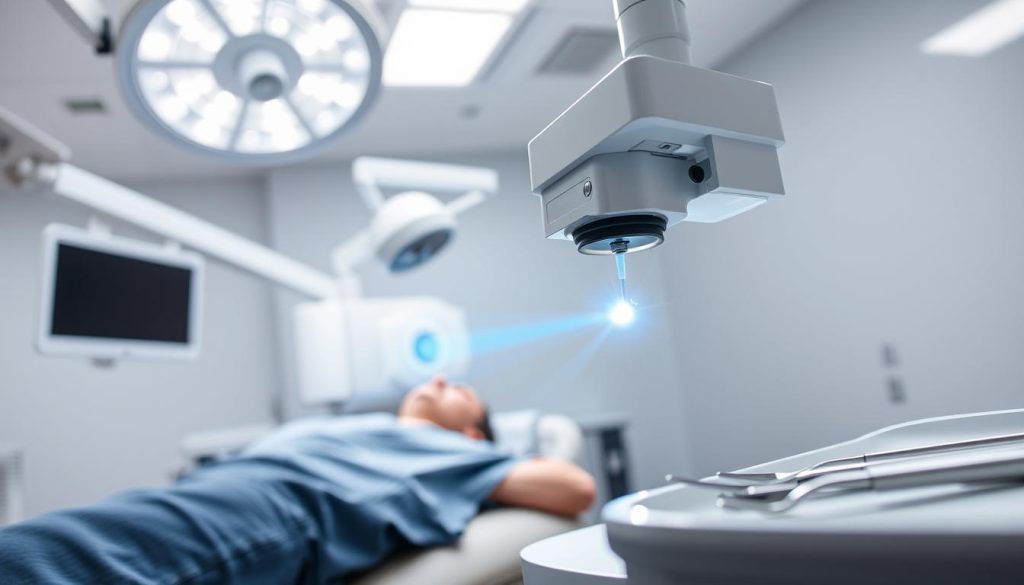LASIK eye surgery has changed the game for vision correction. It gives millions a chance to see clearly without glasses or contacts. This popular procedure reshapes the cornea, tackling common sight issues like nearsightedness, farsightedness, and astigmatism.
As a leading form of laser vision correction, LASIK boasts high success rates and quick recovery times. Patients often see improvement in their eyesight within 24 hours of the surgery. This guide will explore the ins and outs of LASIK, helping you decide if it’s the right choice for your vision needs.
We’ll cover everything from how LASIK works to its benefits, risks, and what to expect during recovery. Whether you’re tired of dependency on corrective lenses or simply curious about this life-changing procedure, read on to gain a clear view of LASIK eye surgery.
Understanding LASIK Eye Surgery: The Basics
LASIK eye surgery has changed how we correct vision. It uses laser technology to reshape the cornea. This makes focusing easier and reduces the need for glasses or contacts.
How LASIK Technology Works
In LASIK, a thin flap is made in the cornea. Then, a precise laser reshapes the tissue underneath. This laser treatment fixes vision problems by changing how light enters the eye.
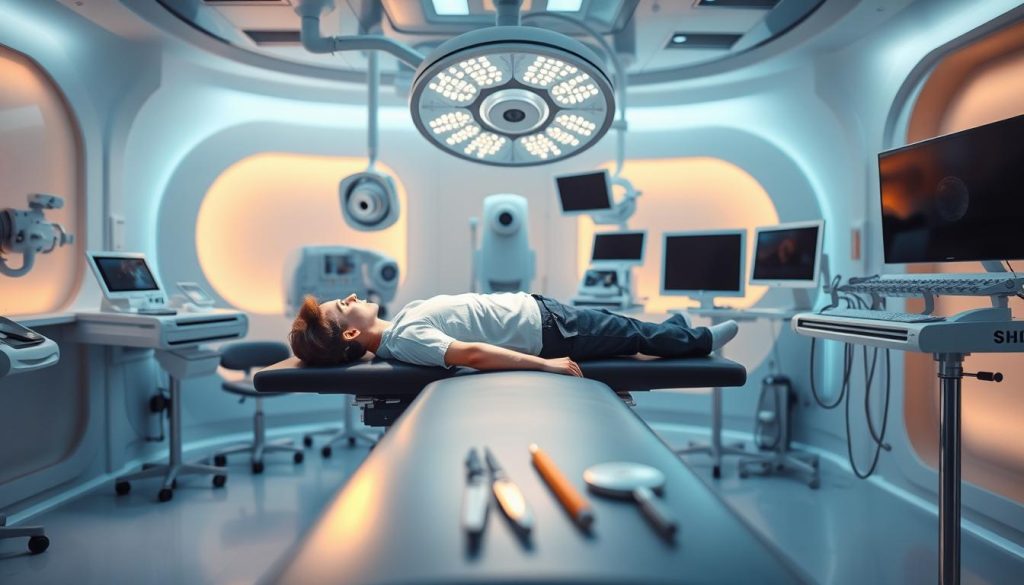
Types of Vision Problems LASIK Can Correct
LASIK can fix several common vision issues:
- Nearsightedness (myopia)
- Farsightedness (hyperopia)
- Astigmatism
By reshaping the cornea, LASIK helps light focus right on the retina. This leads to clearer vision.
The Evolution of Laser Eye Surgery
Laser eye treatment has evolved a lot. Early methods were not as precise or safe. Now, LASIK is safer, more accurate, and tailored to each person.
Wavefront-guided LASIK, for example, maps the eye in detail. This allows for treatments that fit each person’s needs perfectly.
“LASIK has transformed millions of lives, making vision correction safer and more effective.” – American Academy of Ophthalmology
As technology improves, LASIK stays at the top of vision correction. It offers patients amazing results.
Benefits and Advantages of Laser Vision Correction
Laser vision correction can change lives for those with poor eyesight. It reshapes the cornea to improve focus and clarity. Let’s look at why it’s a top choice for vision correction.

One big plus is better vision quality. Many people see 20/20 or better after LASIK. This clear sight makes daily life much better.
Another big plus is not needing glasses or contacts. Most people can ditch their eyewear after laser surgery. This is great for sports fans and outdoor lovers.
- Quick recovery time
- Minimal discomfort during and after the procedure
- Long-term cost savings on eyewear and eye care products
- Improved night vision for many patients
The convenience is huge. No more lost glasses or dry eyes from contacts. Laser surgery offers a lasting fix to these problems.
| Aspect | Before LASIK | After LASIK |
|---|---|---|
| Vision Quality | Blurry without correction | Clear, often 20/20 or better |
| Dependency on Eyewear | High | Low to none |
| Sports Participation | Challenging | Easier and more enjoyable |
| Night Vision | Often poor | Typically improved |
Are You a Suitable Candidate for LASIK?
LASIK eye surgery has changed the game for many. But, not everyone is a perfect match for this surgery. Knowing what makes you a good candidate can help you decide if LASIK is right for you.
Age Requirements and Considerations
Most doctors say you should be at least 18 to get LASIK. This is because your eyes and vision should have stopped changing. Some doctors even suggest waiting until your mid-20s.
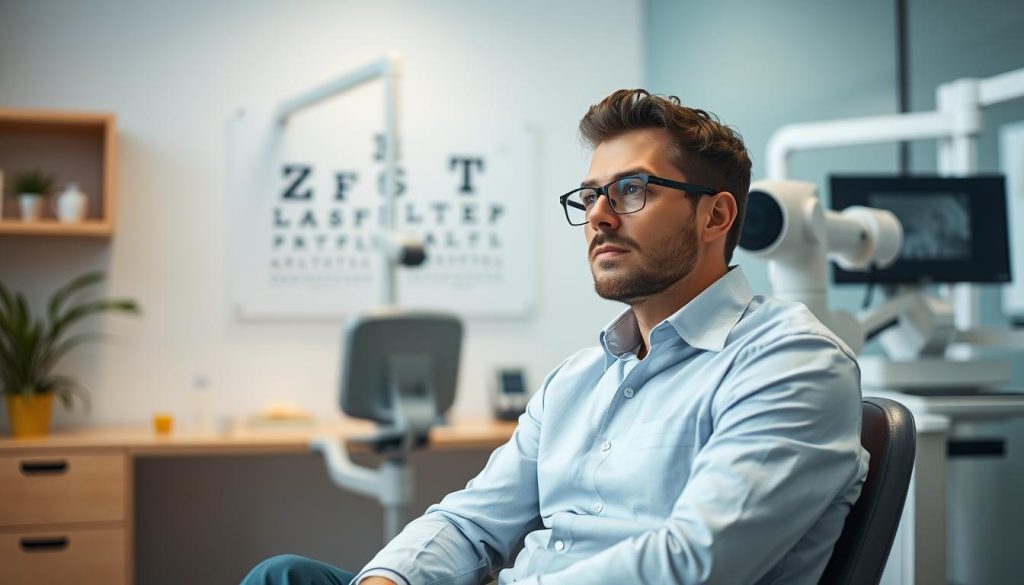
Medical Conditions That May Affect Eligibility
Some health problems can make LASIK tricky. These include:
- Autoimmune disorders
- Diabetes
- Dry eye syndrome
- Glaucoma
- Cataracts
Your eye doctor will check your health history. They’ll see if any conditions could affect the surgery or healing.
Vision Stability Requirements
Having stable vision is key for LASIK success. Your prescription should not have changed in a year before surgery. This makes sure the reshaping of your cornea will last.
| Factor | Requirement |
|---|---|
| Age | 18+ years old |
| Vision Stability | Unchanged for 1+ year |
| Corneal Thickness | Adequate for reshaping |
| Pupil Size | Not excessively large |
Getting a detailed eye exam is vital to see if LASIK is for you. A qualified eye doctor will check your eye health. They’ll talk about if LASIK is a good choice for you.
The Complete LASIK Procedure Timeline
LASIK is a quick way to fix your vision. Knowing the timeline can help ease worries and set clear expectations for those thinking about it.
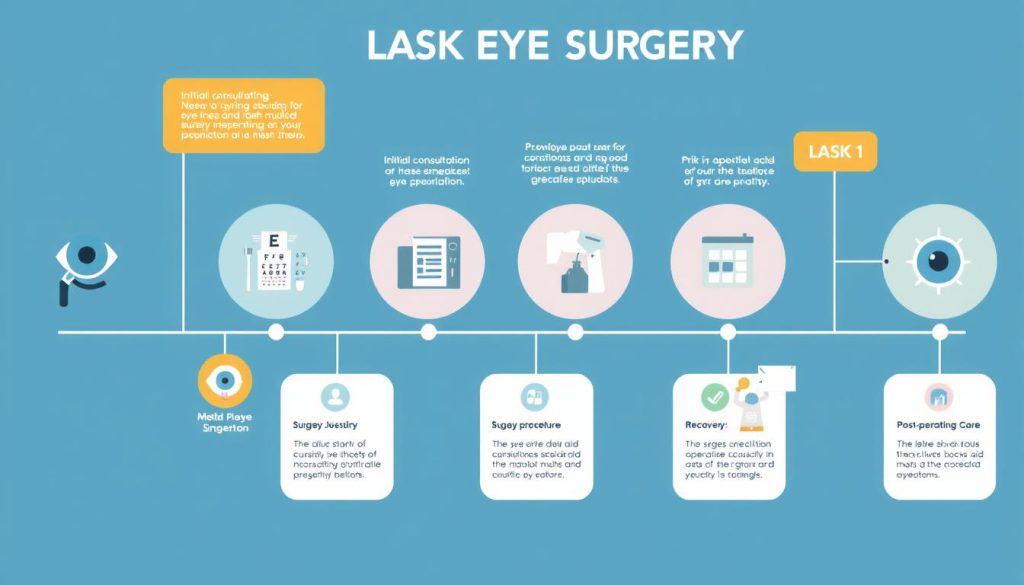
Your journey starts with a first meeting. Your eye doctor will check if LASIK is right for you. They’ll look at your vision, corneal thickness, and eye health.
On the day of surgery, you’ll feel a mix of excitement and nerves. The LASIK itself is fast, taking about 15 minutes per eye. You’ll relax as the surgeon uses lasers to change your cornea, fixing your vision.
Right after, you might feel some pain and blurry vision. This is normal and usually goes away in a few hours. Most people see big improvements in their vision the next day.
It’s important to go back for follow-up visits. You’ll see your doctor at 24 hours, one week, and one month after surgery. These visits check if your eyes are healing right and help with any issues.
Even though the start of recovery is quick, it can take up to six months for your vision to fully settle. Over this time, you’ll see your vision getting better and your life improving.
LASIK’s fast timeline makes it a popular choice for fixing vision. From your first meeting to seeing clearly, the whole process is designed to be quick and easy.
Advanced Technology in Modern LASIK Surgery
LASIK surgery has evolved a lot. Today, it uses cutting-edge tech for safer and more precise treatments. Let’s look at some of the latest tools in LASIK.
Wavefront-Guided Technology
Wavefront-guided LASIK is a big step up from earlier laser eye surgeries. It makes a detailed 3D map of each eye. This lets surgeons tailor treatments to each patient’s needs.
By fixing unique eye problems, wavefront-guided LASIK can improve vision quality. It can also make vision clearer.
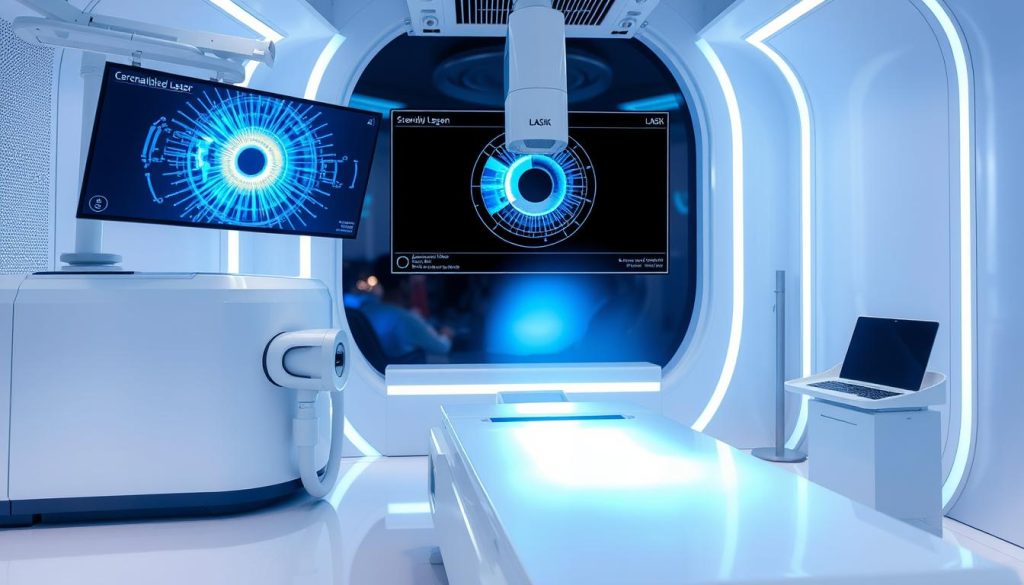
Femtosecond Laser Systems
Femtosecond lasers have changed how corneal flaps are made in LASIK. They are faster and more precise than old methods. These lasers make flaps that are just the right size and thickness.
This reduces the chance of flap problems during surgery.
Topography-Guided Treatments
Topography-guided LASIK considers each patient’s cornea shape. This makes treatments more personalized. It can lead to better vision, even for those with irregular corneas or past eye surgeries.
| Technology | Key Benefits | Best Suited For |
|---|---|---|
| Wavefront-Guided LASIK | Improved night vision, reduced glare | Patients with higher-order aberrations |
| Femtosecond Lasers | Precise flap creation, faster healing | All LASIK candidates |
| Topography-Guided LASIK | Better outcomes for irregular corneas | Patients with corneal irregularities |
These advanced tools make LASIK safer and more effective. They help patients get the clearest vision possible.
Preparing for Your LASIK Eye Surgery
Getting ready for LASIK eye surgery is a big step. It starts with a detailed eye exam and a chat with your surgeon. This first meeting helps the doctor check your eye health and see if LASIK is right for you.
It’s important to stop wearing contact lenses before surgery. Contacts can change your cornea’s shape, which might mess up the measurements. Your doctor will tell you how long to stop wearing them, based on your prescription and contact type.
On surgery day, wear comfy clothes and skip makeup, lotions, and perfumes. These can mess with the clean environment needed for surgery. Also, make sure someone can drive you home because your vision will be blurry right after.
Pre-Surgery Checklist
- Complete all required medical forms
- Follow pre-operative medication instructions
- Eat a light meal before arriving at the clinic
- Bring sunglasses for post-surgery eye protection
By following these steps, you’ll be ready for a smooth LASIK eye surgery. Good preparation is key to a successful vision correction.
| Time Before Surgery | Action |
|---|---|
| 2-4 weeks | Stop wearing contact lenses |
| 1 week | Avoid eye makeup and creams |
| 24 hours | Arrange transportation |
| Day of surgery | Wear comfortable clothing |
Recovery and Healing After LASIK
LASIK surgery makes vision better fast, but healing right is key. Knowing how to care for your eyes after surgery is important.
Immediate Post-Operation Care
After LASIK, you get eye shields and clear instructions. Eye drops help prevent infection and speed up healing. It’s vital to rest your eyes and not rub them for the first 24 hours.
Long-term Recovery Timeline
Vision gets better quickly, and many can go back to work in 1-3 days. It takes 3-6 months to fully recover. Regular check-ups help track your progress and solve any issues.
| Time Post-Surgery | Recovery Milestone |
|---|---|
| 24 hours | Vision clear enough for driving |
| 1 week | Resume non-contact sports |
| 1 month | Swimming allowed |
| 3-6 months | Vision fully stabilized |
Activity Restrictions During Healing
Some activities are off-limits after LASIK to help healing. Avoid swimming, contact sports, and wearing eye makeup for weeks. Managing dry eyes is also key, often needing artificial tears to stay comfortable and heal well.
Potential Risks and Side Effects
Laser eye treatment has many benefits, but it’s important to know the risks and side effects. LASIK surgery, like any medical procedure, has some risks. Patients might feel temporary discomfort, like dry eyes, which usually go away with proper dry eye management.
Common side effects after LASIK include:
- Glare or halos around lights
- Difficulty with night vision
- Temporary increased light sensitivity
- Fluctuating vision clarity
More serious complications, though rare, can happen. These might include undercorrection or overcorrection of vision, which could need more procedures. In very rare cases, vision loss can occur.
To lower risks, pick a qualified surgeon and follow post-operative instructions well. New technology in laser eye treatment has made LASIK safer than before.
“LASIK has evolved a lot, with complication rates dropping to less than 1% in recent years.”
Knowing these possible outcomes helps set realistic expectations for your LASIK journey. Talk to your eye care professional about any worries. This way, you can make an informed choice about your vision correction options.
Cost Considerations and Insurance Coverage
Understanding the costs of lasik eye surgery is key for those thinking about it. Prices can change a lot, based on the technology and the surgeon’s skill.
Average Procedure Costs
In the United States, lasik eye surgery costs between $1,500 and $3,000 per eye. Some clinics might charge up to $5,000 per eye for newer methods. Remember, the cheapest option might not be the best for your eyes.
| Procedure Type | Average Cost per Eye |
|---|---|
| Standard LASIK | $1,500 – $2,500 |
| Custom LASIK | $2,000 – $3,000 |
| Advanced Technology LASIK | $2,500 – $5,000 |
Financing Options Available
Many eye clinics have financing plans to help make lasik more affordable. These plans might offer no-interest payments for 12-24 months or low-interest payments for longer. Some people use healthcare credit cards for medical procedures.
Insurance Policies and LASIK
Most insurance plans don’t cover lasik fully because it’s seen as an elective procedure. Some plans might offer partial coverage or discounts. It’s a good idea to check with your insurance about any vision benefits. Employers might also offer FSAs or HSAs for medical expenses.
Before getting lasik eye surgery, look into all your financial options. Talk to different providers to find the best deal for your vision needs.
Alternative Vision Correction Procedures
LASIK isn’t the only way to correct vision. Many other procedures can help you see clearly without glasses or contacts. Let’s look at some popular options.
PRK (Photorefractive Keratectomy) is an older laser eye surgery. It changes the cornea’s surface directly. It’s good for people with thin corneas. But, recovery takes longer than LASIK, and results are similar.
SMILE (Small Incision Lenticule Extraction) is a newer method. It uses a laser to create a small tissue disc in the cornea. Then, it’s removed through a small cut. This method is great for those with dry eyes because it’s less invasive.
Intraocular lenses are another option. These artificial lenses go inside the eye, either in front of or instead of the natural lens. They can fix many vision problems, including severe nearsightedness or farsightedness.
| Procedure | Recovery Time | Best For |
|---|---|---|
| PRK | 1-3 months | Thin corneas |
| SMILE | 1-2 weeks | Dry eyes |
| Intraocular Lenses | 1-2 weeks | Severe refractive errors |
Your eye doctor can help pick the best surgery for you. Each method has its own benefits and things to consider. A detailed talk with your doctor is important to make the right choice.
Choosing the Right LASIK Surgeon
Finding a skilled LASIK surgeon is key for a successful surgery. Your choice greatly affects your surgery’s outcome.
Certification and Credentials
Look for surgeons with board certification in ophthalmology and LASIK training. These show they meet high eye care standards.
Experience and Success Rates
Ask surgeons about their LASIK experience. Find out how many surgeries they’ve done and their success rates. More successful surgeries mean more experience.
| Experience Level | Procedures Performed | Typical Success Rate |
|---|---|---|
| Novice | Less than 500 | 90-95% |
| Experienced | 500-1000 | 95-98% |
| Expert | Over 1000 | 98-99% |
Patient Reviews and Testimonials
Read reviews from past patients to learn about the surgeon’s skills and results. Look at different sources for a full view.
“My LASIK surgeon’s expertise made all the difference. I’m thrilled with my vision now!” – Sarah K., LASIK patient
During consultations, ask about the surgery, recovery, and risks. A good surgeon will answer clearly and make you feel confident in your choice.
Post-LASIK Vision Care and Maintenance
After LASIK surgery, it’s key to keep your eyes healthy for long-term vision success. Regular eye exams are a must to watch for vision and eye health changes. These visits help spot issues early, keeping your eyes in great shape.
As you get older, you might need reading glasses for presbyopia, a common age issue LASIK can’t stop. To keep your eyes healthy, eat right, protect from UV, and reduce digital eye strain. These steps help your vision and add to LASIK’s benefits.
Dry eye management is vital after LASIK. Some people face dry eye issues after surgery. Here are tips to handle dry eyes:
- Use artificial tears as your eye doctor suggests
- Take breaks from screens often
- Drink lots of water to stay hydrated
- Use a humidifier in dry places
By following these tips and talking often with your eye doctor, you can get the best from LASIK. Remember, caring for your eye health is a long-term job that needs ongoing effort and attention.
Latest Innovations in Corneal Reshaping
The field of corneal reshaping is seeing big changes, giving hope to those looking for vision correction. New laser tech and better precision methods are changing LASIK for the better.
New Laser Technologies
New laser systems have better eye-tracking and faster treatment times. These updates lower the chance of problems and make the process more comfortable for patients.
Wavefront-guided LASIK is a big step up in vision correction. It maps the eye’s unique flaws, letting surgeons make treatments that fit perfectly.
Precision Enhancement Methods
Topography-guided LASIK is taking corneal reshaping even further. It looks at the eye’s surface to give more precise results, great for those with irregular corneas.
| Method | Key Benefit | Best For |
|---|---|---|
| Wavefront-guided LASIK | Customized treatment | Complex vision issues |
| Topography-guided LASIK | Enhanced accuracy | Irregular corneas |
| Femtosecond laser | Bladeless flap creation | Thin corneas |
New tech in corneal reshaping includes advanced eye-tracking and adaptive optics. These advancements aim to bring even more precision and better vision for future LASIK patients.
Managing Expectations and Results
LASIK eye surgery has changed the game for those tired of glasses or contacts. Many patients see 20/20 or better after surgery. But, it’s important to keep expectations in check.
Visual acuity is just one part of your vision. Night vision and contrast sensitivity are also key. Your surgeon will talk about these during your consultation to set realistic goals.
Not everyone gets perfect vision after LASIK. Some might need glasses for certain tasks or in dim light. Talking openly with your doctor about what you want is essential.
“Understanding that LASIK is a medical procedure with varying outcomes helps patients approach the process with realistic expectations.”
If your vision isn’t perfect right away, there might be follow-up options. These can tweak your vision, but they’re not always needed. Your surgeon will help decide based on your situation.
- Be prepared for a healing period
- Follow post-operative instructions carefully
- Attend all follow-up appointments
- Communicate any concerns with your eye care team
By setting realistic expectations and talking openly with your surgeon, you can be happier with your LASIK results.
Long-term Success Rates and Studies
LASIK eye surgery has shown impressive long-term success rates, according to numerous studies. Research spanning over 20 years reveals that most patients maintain improved vision well after their procedure. A study published in the Journal of Cataract & Refractive Surgery found that 95% of LASIK patients achieved 20/20 vision or better after 5 years.
When compared to other procedures like photorefractive keratectomy (PRK), LASIK often provides faster visual recovery. Both surgeries offer similar long-term outcomes, but LASIK patients typically experience less discomfort and quicker healing. Advances in laser technology have further enhanced LASIK’s precision, leading to even better results over time.
Factors contributing to LASIK’s long-term success include careful patient selection and customized treatment plans. Modern eye-tracking systems and wavefront-guided lasers allow surgeons to tailor the procedure to each patient’s unique eye shape. While some patients may need a touch-up procedure years later, the need for retreatment has decreased with improved surgical techniques.
As technology continues to evolve, LASIK eye surgery remains a safe and effective option for vision correction. Patients considering the procedure can feel confident in its long-term benefits, backed by extensive research and positive outcomes reported by millions of individuals worldwide.
FAQ
Q: What is LASIK eye surgery?
A: LASIK is a surgery that reshapes the cornea with laser technology. It corrects vision problems like nearsightedness and farsightedness. This makes it easier to see without glasses or contact lenses.
Q: How long does the LASIK procedure take?
A: The LASIK surgery itself takes about 15 minutes per eye. But, you should plan to spend a few hours at the clinic. This is for preparation and recovery.
Q: Is LASIK painful?
A: LASIK is not painful. You might feel some pressure, but numbing drops are used. You might feel some discomfort or irritation in the first few days.
Q: What is the typical recovery time for LASIK?
A: You can see improvement in your vision within 24 hours. It can take a few weeks to a few months for full recovery. You can usually go back to work and normal activities in a day or two.
Q: Who is a good candidate for LASIK?
A: Adults over 18 with stable vision for at least a year are good candidates. You need to have enough corneal thickness and no eye diseases. A detailed eye exam is needed to check if you’re eligible.
Q: What are the possible risks and side effects of LASIK?
A: Risks and side effects include dry eyes and vision problems like glare. Serious but rare complications include vision loss. New technology has made these risks lower.
Q: How much does LASIK cost?
A: LASIK costs vary based on technology, surgeon experience, and location. It usually costs between ,000 to ,000 per eye. Many clinics offer financing to help with the cost.
Q: Does insurance cover LASIK?
A: Most insurance plans don’t cover LASIK because it’s considered elective. But, some plans might offer discounts. It’s best to check with your insurance provider.
Q: What is wavefront-guided LASIK?
A: Wavefront-guided LASIK uses 3D mapping to create a detailed image of your eye. This allows for more precise treatment, potentially leading to better results.
Q: How long do LASIK results last?
A: LASIK results are usually long-lasting. But, age-related changes can affect your vision over time. You might need reading glasses as you get older, even with LASIK.
Q: Are there alternatives to LASIK?
A: Yes, alternatives include PRK, SMILE, and intraocular lens implants. These options might be better for those not ideal for LASIK.
Q: How do I choose the right LASIK surgeon?
A: Look for a board-certified ophthalmologist with LASIK experience. Check their success rates, patient reviews, and technology used. You should feel confident with your chosen surgeon.
Q: What is dry eye management after LASIK?
A: Dry eye is a common side effect after LASIK. It’s managed with artificial tears and eye drops. Symptoms usually improve within a few months.
Q: Can LASIK correct presbyopia?
A: Traditional LASIK doesn’t correct presbyopia, the age-related difficulty in focusing on close objects. But, monovision LASIK can help address these symptoms.
Q: What are femtosecond lasers in LASIK?
A: Femtosecond lasers are advanced systems used in LASIK. They create the corneal flap with precision and safety. This can lead to better outcomes and faster recovery.












